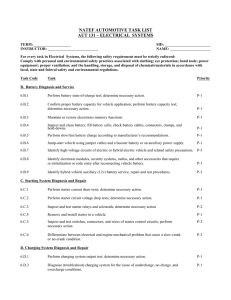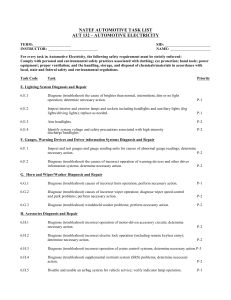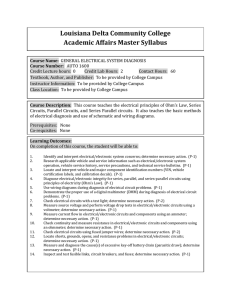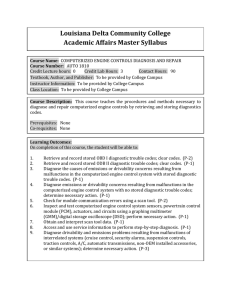AUTOMOTIVE ELECTRICAL/ELECTRONICS (NATEF
advertisement
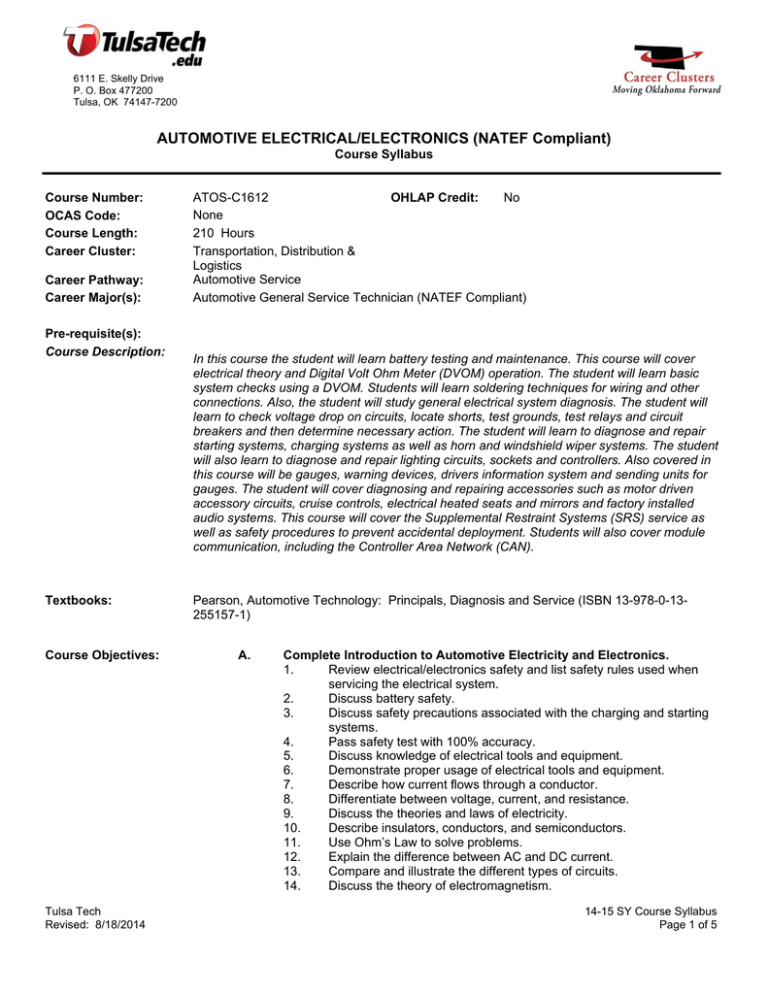
6111 E. Skelly Drive P. O. Box 477200 Tulsa, OK 74147-7200 AUTOMOTIVE ELECTRICAL/ELECTRONICS (NATEF Compliant) Course Syllabus Course Number: OCAS Code: Course Length: Career Cluster: Career Pathway: Career Major(s): Pre-requisite(s): Course Description: Textbooks: Course Objectives: Tulsa Tech Revised: 8/18/2014 ATOS-C1612 No OHLAP Credit: None 210 Hours Transportation, Distribution & Logistics Automotive Service Automotive General Service Technician (NATEF Compliant) In this course the student will learn battery testing and maintenance. This course will cover electrical theory and Digital Volt Ohm Meter (DVOM) operation. The student will learn basic system checks using a DVOM. Students will learn soldering techniques for wiring and other connections. Also, the student will study general electrical system diagnosis. The student will learn to check voltage drop on circuits, locate shorts, test grounds, test relays and circuit breakers and then determine necessary action. The student will learn to diagnose and repair starting systems, charging systems as well as horn and windshield wiper systems. The student will also learn to diagnose and repair lighting circuits, sockets and controllers. Also covered in this course will be gauges, warning devices, drivers information system and sending units for gauges. The student will cover diagnosing and repairing accessories such as motor driven accessory circuits, cruise controls, electrical heated seats and mirrors and factory installed audio systems. This course will cover the Supplemental Restraint Systems (SRS) service as well as safety procedures to prevent accidental deployment. Students will also cover module communication, including the Controller Area Network (CAN). Pearson, Automotive Technology: Principals, Diagnosis and Service (ISBN 13-978-0-13255157-1) A. Complete Introduction to Automotive Electricity and Electronics. 1. Review electrical/electronics safety and list safety rules used when servicing the electrical system. 2. Discuss battery safety. 3. Discuss safety precautions associated with the charging and starting systems. 4. Pass safety test with 100% accuracy. 5. Discuss knowledge of electrical tools and equipment. 6. Demonstrate proper usage of electrical tools and equipment. 7. Describe how current flows through a conductor. 8. Differentiate between voltage, current, and resistance. 9. Discuss the theories and laws of electricity. 10. Describe insulators, conductors, and semiconductors. 11. Use Ohm’s Law to solve problems. 12. Explain the difference between AC and DC current. 13. Compare and illustrate the different types of circuits. 14. Discuss the theory of electromagnetism. 14-15 SY Course Syllabus Page 1 of 5 AUTOMOTIVE ELECTRICAL/ELECTRONICS (NATEF Compliant) 15. Explain the principles of induction. B. General: Electrical System Diagnosis 1. Research applicable vehicle and service information, vehicle service history, service precautions, and technical service bulletins. P-1 2. Demonstrate knowledge of electrical/electronic series, parallel, and series-parallel circuits using principles of electricity (Ohm’s Law). P-1 3. Demonstrate proper use of a digital multimeter (DMM) when measuring source voltage, voltage drop (including grounds), current flow and resistance. P-1 4. Demonstrate knowledge of the causes and effects from shorts, grounds, opens, and resistance problems in electrical/electronic circuits. P-1 5. Check operation of electrical circuits with a test light. P-1 6. Check operation of electrical circuits with fused jumper wires. P-1 7. Use wiring diagrams during the diagnosis (troubleshooting) of electrical/electronic circuit problems. P-1 8. Diagnose the cause(s) of excessive key-off battery drain (parasitic draw); determine necessary action. P-1 9. Inspect and test fusible links, circuit breakers, and fuses; determine necessary action. P-1 10. Inspect and test switches, connectors, relays, solenoid solid state devices, and wires of electrical/electronic circuits; determine necessary action. P-1 11. Replace electrical connectors and terminal ends. 12. Repair wiring harness. P-1 P-3 13. Perform solder repair of electrical wiring. P-1 C. Battery Diagnosis and Service 1. Perform battery state-of-charge test; determine necessary action. P-1 2. Confirm proper battery capacity for vehicle application; perform battery capacity test; determine necessary action. P-1 3. Maintain or restore electronic memory functions. P-1 4. Inspect and clean battery; fill battery cells; check battery cables, connectors, clamps, and hold-downs. P-1 Tulsa Tech Revised: 8/18/2014 14-15 SY Course Syllabus Page 2 of 5 AUTOMOTIVE ELECTRICAL/ELECTRONICS (NATEF Compliant) 5. Perform slow/fast battery charge according to manufacturer’s recommendations. P-1 6. Jump-start vehicle using jumper cables and a booster battery or an auxiliary power supply. P-1 7. Identify high-voltage circuits of electric or hybrid electric vehicle and related safety precautions. P-3 8. Identify electronic modules, security systems, radios, and other accessories that require reinitialization or code entry after reconnecting vehicle battery. P-1 9. Identify hybrid vehicle auxiliary (12v) battery service, repair, and test procedures. P-3 D. Starting System Diagnosis and Repair 1. Perform starter current draw tests; determine necessary action. P-1 2. Perform starter circuit voltage drop tests; determine necessary action. P-1 3. Inspect and test starter relays and solenoids; determine necessary action. P-2 4. Remove and install starter in a vehicle. P-1 5. Inspect and test switches, connectors, and wires of starter control circuits; determine necessary action. P-2 6. Differentiate between electrical and engine mechanical problems that cause a slow-crank or a no-crank condition. P-2 E. Charging System Diagnosis and Repair 1. Perform charging system output test; determine necessary action. P-1 2. Diagnose (troubleshoot) charging system for causes of undercharge, no-charge, or overcharge conditions. P-1 3. Inspect, adjust, or replace generator (alternator) drive belts; check pulleys and tensioners for wear; check pulley and belt alignment. P-1 4. Remove, inspect, and re-install generator (alternator). P-1 5. Perform charging circuit voltage drop tests; determine necessary action. P-1 F. Lighting Systems Diagnosis and Repair 1. 1. Diagnose (troubleshoot) the causes of brighter-than-normal, intermittent, dim, or no light operation; determine necessary action. P-1 2. Inspect interior and exterior lamps and sockets including headlights and auxiliary lights (fog lights/driving lights); replace as needed. P-1 Tulsa Tech Revised: 8/18/2014 14-15 SY Course Syllabus Page 3 of 5 AUTOMOTIVE ELECTRICAL/ELECTRONICS (NATEF Compliant) 3. Aim headlights. P-2 4. Identify system voltage and safety precautions associated with high-intensity discharge headlights. P-2 G. Gauges, Warning Devices, and Driver Information Systems Diagnosis and Repair 1. Inspect and test gauges and gauge sending units for causes of abnormal gauge readings; determine necessary action. P-2 2. Diagnose (troubleshoot) the causes of incorrect operation of warning devices and other driver information systems; determine necessary action. P-2 H. Horn and Wiper/Washer Diagnosis and Repair 1. Diagnose (troubleshoot) causes of incorrect horn operation; perform necessary action. P-1 2. Diagnose (troubleshoot) causes of incorrect wiper operation; diagnose wiper speed control and park problems; perform necessary action. P-2 3. Diagnose (troubleshoot) windshield washer problems; perform necessary action. P-2 H. Accessories Diagnosis and Repair 1. Diagnose (troubleshoot) incorrect operation of motor-driven accessory circuits; determine necessary action. P-2 2. Diagnose (troubleshoot) incorrect electric lock operation (including remote keyless entry); determine necessary action. P-2 3. Diagnose (troubleshoot) incorrect operation of cruise control systems; determine necessary action. P-3 4. Diagnose (troubleshoot) supplemental restraint system (SRS) problems; determine necessary action. P-2 5. Disable and enable an airbag system for vehicle service; verify indicator lamp operation. P-1 6. Remove and reinstall door panel. 7. Check for module communication errors (including CAN/BUS systems) using a scan tool. P-2 8. Describe the operation of keyless entry/remote-start systems. P-1 P-3 9. Verify operation of instrument panel gauges and warning/indicator lights; reset maintenance indicators. P-1 Tulsa Tech Revised: 8/18/2014 14-15 SY Course Syllabus Page 4 of 5 AUTOMOTIVE ELECTRICAL/ELECTRONICS (NATEF Compliant) 10. Verify windshield wiper and washer operation, replace wiper blades. P-1 1 ASE objective All unmarked objectives are TTC instructor developed. Teaching Methods: The class will primarily be taught by the lecture and demonstration method and supported by various media materials to address various learning styles. There will be question and answer sessions over material covered in lecture and media presentations. Supervised lab time is provided for students to complete required projects. Grading Procedures: 1. Students are graded on theory and shop practice and performance. 2. Each course must be passed with seventy (70%) percent or better. 3. Grading scale: A=90-100%, B=80-89%, C=70-79%, D=60-69%, F=50-59%. Description of Classroom, Laboratories, and Equipment: Tulsa Technology Center campuses are owned and operated by Tulsa Technology Center School District No. 18. All programs provide students the opportunity to work with professionally certified instructors in modern, well-equipped facilities. Available Certifications/ College Credit The student may be eligible to take state, national or industry exam after completion of the program. College credit may be issued from Oklahoma State University-Okmulgee or Tulsa Community College. See program counselor for additional information. College Credit Eligibility: 1. The student must maintain a grade point average of seventy (70%) percent or better. 2. The student must maintain an attendance record of ninety (90%) or better. Tulsa Tech Revised: 8/18/2014 14-15 SY Course Syllabus Page 5 of 5


